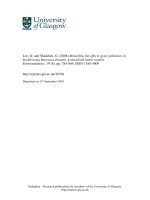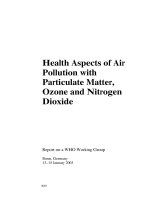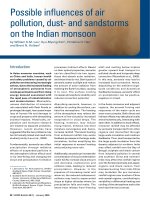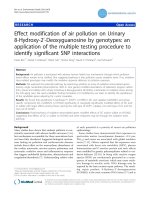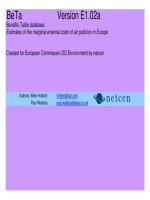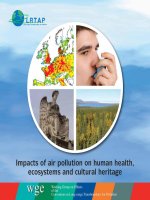Fundamentals of Air Pollution 3E
Bạn đang xem bản rút gọn của tài liệu. Xem và tải ngay bản đầy đủ của tài liệu tại đây (20.95 MB, 595 trang )
Fundamentals
of
Air
Pollution
THIRD
EDITION
RICHARD
W.
BOUBEL
Department
of
Mechanical Engineering
Oregon State University
Corvallis, Oregon
DONALD
L. FOX
Department
of
Environmental Science
School
of
Public Health
University
of
North Carolina
Chapel
Hill,
North
Carolina
D.
BRUCE TURNER
Trinity
Consultants,
Inc.
Chapel
Hill,
North Carolina
ARTHUR
C.
STERN
(14
March
1909-17
April 1992)
Fundamentals
of
Air
Pollution
THIRD
EDITION
ACADEMIC PRESS
San
Diego
New
York
Boston London Sydney Tokyo Toronto
Cover
photograph: Testing
an air
pollution source
for
particulate emissions.
Photo courtesy
of BWR
Associates, Medford, Oregon
This
book
is
printed
on
acid-free paper.
Copyright 1994, 1984, 1973, Elsevier (USA)
All
rights reserved.
No
part
of
this publication
may be
reproduced
or
transmitted
in any
form
or by any
means, electronic
or
mechanical, including photocopy, recording,
or any
information
storage
and
retrieval system, without permission
in
writing
from
the
publisher.
Requests
for
permission
to
make copies
of any
part
of the
work should
be
mailed
to:
Permissions Department, Harcourt, Inc., 6277
Sea
Harbor Drive, Orlando, Florida 32887-6777,
Academic Press
An
imprint
of
Elsevier
525
B
Street, Suite 1900,
San
Diego, California 92101-4495,
USA
Academic
Press
84
Theobald's
Road, London WC1X 8RR,
UK
Library
of
Congress Cataloging-in-Publication Data
Fundamentals
of air
pollution
/
Richard
W.
Boubel
{et
al.}. -3
rd
ed
p.
cm
Includes bibliographical references
and
index.
ISBN 0-12-118930-9
I.
Air—Pollution.
2.
Air—Pollution—Law
and
legislation—United States.
1
Boubel, Richard
W.
(Richard William), DATE.
TD883.F86 1994
363.73'92—dc20 94-2121
CIP
PRINTED
IN THE
UNITED STATES
OF
AMERICA
03
04 05 06
98765
Dedication
Dedicated
to
Arthur
C.
Stern,
the
pioneer
in air
pollution science
and
engineering,
by
three humble followers.
He was our
mentor, taskmaster,
and
friend.
This page intentionally left blank
Contents
PREFACE
xvii
Part
I
The
Elements
of
Air
Pollution
1 The
History
of
Air
Pollution
I.
Before
the
Industrial Revolution
3
II.
The
Industrial Revolution
4
III.
The
Twentieth Century
8
IV.
The
1980s
14
V,
The
1990s
15
VI.
The
Future
16
References
16
Suggested Reading
18
Questions
18
2 The
Natural
versus
Polluted Atmosphere
I.
The
Atmosphere
19
II.
Unpolluted
Air 20
III.
Particulate Matter
22
IV.
Concepts
29
vii
viii
Contents
References
33
Suggested Reading
33
Questions
33
3
Scales
of
the Air
Pollution Problem
I.
Local
35
II.
Urban
36
III.
Regional
37
IV.
Continental
38
V.
Global
38
Suggested
Reading
39
Questions
39
4 Air
Quality
I.
Averaging Time
41
II.
Cycles
43
III.
Primary
and
Secondary Pollutants
44
IV.
Measurement Systems
47
V.
Air
Quality Levels
48
Reference
59
Suggested Reading
59
Questions
59
5 The
Philosophy
of
Air
Pollution Control
I.
Strategy
and
Tactics—The
Air
Pollution System
61
II.
Episode Control
62
III.
Air
Quality Management Control Strategy
66
IV.
Alternative
Control
Strategies
68
V.
Economic Considerations
70
Reference
71
Suggested Reading
71
Questions
71
6
Sources
of
Air
Pollution
I.
General
72
II.
Combustion
78
III.
Stationary Sources
81
IV.
Mobile Sources
91
V.
Emission Inventory
92
References
95
Suggested Reading
96
Questions
96
Contents
ix
Part
II
The
Effects
of Air
Pollution
7
Effects
on
Human Health
and
Welfare
1.
Air-Water-Soil Interactions
99
II.
Total Body Burden
101
III.
The
Human Respiratory System
103
IV.
Impact
of Air
Pollution
on
Humans
106
V.
Impact
of
Odor
on
Humans
108
References
108
Suggested
Reading
109
Questions
109
8
Effects
on
Vegetation
and
Animals
I.
Injury
versus Damage
110
II.
Effects
on
Vegetation
and
Crops
112
III.
Effects
on
Forests
116
IV.
Effects
on
Animals
121
References
124
Suggested Reading
125
Questions
125
9
Effects
on
Materials
and
Structures
I.
Effects
on
Metals
126
II.
Effects
on
Stone
129
III.
Effects
on
Fabrics
and
Dyes
130
IV.
Effects
on
Leather, Paper, Paint,
and
Glass
132
V.
Effects
on
Rubber
133
References
134
Suggested Reading
135
Questions
135
10
Effects
on the
Atmosphere, Soil,
and
Water
Bodies
I.
The
Physics
of
Visibility
136
II.
Formation
of
Atmospheric
Haze
144
III.
Effects
of
Atmospheric Haze
146
IV.
Visibility
148
V.
Acidic Deposition
149
VI.
Effects
of
Acidic Deposition
152
References
153
Suggested Reading
154
Questions
155
X
Contents
11
Long-Term
Effects
on the
Planet
I.
Global Warming
156
II.
Ozone Holes
159
References
161
Suggested
Reading
162
Questions
162
Part
III
Measurement
and
Monitoring
of
Air
Pollution
12
Atmospheric Chemistry
I.
Types
of
Atmospheric Chemical Transformations
165
II.
Role
of
Solar Radiation
in
Atmospheric Chemistry
167
HI.
Gas-Phase Chemical Reaction Pathways
168
IV.
Heterogeneous
Reactions
176
V.
Scavenging
and
Removal
from
the
Atmosphere
176
References
177
Suggested Reading
177
Questions
177
13
Ambient
Air
Sampling
I.
Elements
of a
Sampling System
179
II.
Sampling Systems
for
Gaseous Pollutants
181
III.
Sampling Systems
for
Particulate Pollutants
and
PM
10
186
IV.
Static Sampling Systems
189
V.
Sampler Siting Requirements
191
VI.
Sampling
for Air
Toxics
192
References
193
Suggested Reading
193
Questions
193
14
Ambient
Air
Pollutants: Analysis
and
Measurement
I.
Analysis
and
Measurement
of
Gaseous Pollutants
195
II.
Analysis
and
Measurement
of
Particulate Pollutants
203
III.
Analysis
and
Measurement
of
Odors
206
IV.
Analysis
and
Measurement
of
Visibility
208
V.
Analysis
and
Measurement
of
Acidic
Deposition
209
References
213
Suggested Reading
214
Questions
214
Contents
XI
15
Air
Pollution Monitoring
and
Surveillance
I.
Stationary Monitoring Networks
216
II.
Mobile Monitoring
and
Surveillance
218
III.
Remote
Sensing
221
IV.
Quality Assurance
222
V.
Data Analysis
and
Display
226
References
227
Suggested Reading
228
Questions
228
16
Air
Pathways from Hazardous Waste Sites
I.
Introduction
229
II.
Multimedia Transport
230
III.
Contaminant Fate Analysis
230
IV.
Modeling
237
References
240
Suggested
Reading
240
Questions
240
Part
IV
The
Meteorology
of
Air
Pollution
17 The
Physics
of the
Atmosphere
I.
Sun, Atmosphere System,
and
Heat Balance
243
II.
Stability
and
Instability
250
III.
Laws
of
Motion
257
IV.
Local
Wind Systems
262
V.
General Circulation
268
References
272
Suggested Reading
273
Questions
273
18 The
Meteorological Bases
of
Atmospheric Pollution
I.
Ventilation
275
II.
Stagnation
277
III.
Meterological
Conditions
during Historic
Pollution Episodes
278
IV.
Effects
of
Pollution
on the
Atmosphere
284
V.
Removal Mechanisms
286
References
288
Suggested Reading
289
Questions
289
xii
Contents
19
Transport
and
Dispersion
of
Air
Pollutants
I.
Wind Velocity
291
II.
Turbulence
293
III.
Estimating Concentrations
from
Point Sources
296
IV.
Dispersion Instrumentation
306
V.
Atmospheric Tracers
312
VI.
Concentration Variation with Averaging Time
315
References
317
Suggested Reading
318
Questions
318
20 Air
Pollution
Modeling
and
Prediction
I.
Plume Rise
321
II.
Modeling Techniques
324
III.
Modeling
Nonreactive
Pollutants
327
IV.
Modeling Pollutant Transformations
330
V.
Model Performance, Accuracy,
and
Utilization
332
References
340
Suggested Reading
343
Questions
343
21
Air
Pollution
Climatology
I.
Sources
of
Data
345
II.
Representativeness
349
III.
Frequency
of
Atmospheric Stagnations
352
IV.
Ventilation Climatology
354
V.
Wind
and
Pollution Roses
357
References
362
Suggested Reading
362
Questions
362
Part
V
The
Regulatory
Control
of
Air
Pollution
22 Air
Quality
Criteria
and
Standards
I.
Air
Quality Criteria
367
II.
Conversion
of
Effects
Data
and
Criteria
to
Standards
368
III.
Conversion
of
Physical Data
and
Criteria
to
Standards
373
IV.
Conversion
of
Biological Data
and
Criteria
to
Standards
376
V.
Air
Quality Standards
377
Suggested Reading
381
Questions
381
Contents
xiii
23
Indoor
Air
Quality
I.
Changing Times
382
II.
Factors Influencing Indoor
Air
Quality
384
III.
Indoor
Air
Pollutants
385
IV.
Effects
of
Indoor
Air
Pollutants
388
V.
Control
of
Indoor Pollutants
389
References
394
Suggested Readings
394
Questions
394
24 The
U.S.
Clean
Air Act
Amendments
of
1990
I.
Introduction
395
II.
Titles
397
References
406
Suggested Reading
406
Questions
407
25
Emission
Standards
I.
Subjective
Standards
408
II.
Objective
Standards
410
III.
Types
of
Emission Standards
411
IV.
Variant Forms
of
Emission Standards
411
V.
Means
for
Implementing Emission Standards
415
References
418
Suggested Reading
419
Questions
419
26 The
Elements
of
Regulatory
Control
I.
Control
of New
Stationary
Sources
421
II.
Control
of
Existing Stationary Sources
422
III.
Control
of
Mobile Sources
423
IV.
Air
Quality Control Regions
424
V.
Tall
Stacks
and
Intermittent
and
Supplementary
Control Systems
425
References
426
Suggested
Reading
426
Questions
426
27
Organizations
for Air
Pollution
Control
I.
Functions
428
II.
Organization
431
III.
Finance
434
xiv
Contents
IV.
Personnel
436
V.
Advisory Groups
440
Suggested Reading
443
Questions
443
Part
VI
The
Engineering
Control
of
Air
Pollution
28
Engineering
Control
Concepts
I.
Introduction
447
II.
Process
Change
449
III.
Fuel Change
450
IV.
Pollution Removal
451
V.
Disposal
of
Pollutants
453
VI.
Pollution Prevention
455
References
458
Suggested
Reading
458
Questions
459
29
Control
Devices
and
Systems
I.
Introduction
460
II.
Removal
of Dry
Participate Matter
462
III.
Removal
of
Liquid Droplets
and
Mists
474
IV.
Removal
of
Gaseous Pollutants
477
V.
Removal
of
Odors
485
References
487
Suggested Reading
487
Questions
487
30
Control
of
Stationary
Sources
I.
Introduction
489
II.
Energy, Power,
and
Incineration
490
III.
Chemical
and
Metallurgical Industries
497
IV.
Agriculture
and
Forest Products Industries
509
V.
Other Industrial Processes
515
References
521
Suggested Reading
522
Questions
522
Contents
XV
31
Control
of
Mobile
Sources
I.
Introduction
523
II.
Gasoline-Powered Vehicles
523
III.
Diesel-Powered Vehicles
526
IV,
Gas
Turbines
and Jet
Engines
526
V.
Alternatives
to
Existing Mobile Sources
527
References
530
Suggested Reading
530
Questions
530
32
Source
Sampling
and
Monitoring
I.
Introduction
532
II.
Source Sampling
532
III.
Statistics
of
Sampling
534
IV.
The
Source Test
536
V.
Source Monitoring
547
References
552
Suggested Reading
552
Questions
552
INDEX
555
This page intentionally left blank
Preface
The
authors
of
this book include
a
chemist (Donald
L.
Fox),
a
meteorolo-
gist
(D.
Bruce
Turner),
and a
mechanical engineer (Richard
W.
Boubel).
This
1:1:1 ratio
has
some relevance
in
that
it
approximates
the
ratio
of
those
professionally
involved
in the
field
of air
pollution.
In the
environmental
protection
and
management
field,
the
experience
of the
recent past
has
been that physicists
and
electrical
engineers
have been most attracted
to
the
radiation, nuclear,
and
noise
areas; biologists
and
civil
engineers
to the
aquatic
and
solid waste areas; chemists, meteorologists,
and
chemical
and
mechanical
engineers
to the
area
of air
pollution
and its
control. These
remarks
are not
intended
to
exclude
all
others
from
the
party
(or
from
this
course).
The
control
of air
pollution requires
the
combined
efforts
of all the
professions
mentioned,
in
addition
to the
input
of
physicians, lawyers,
and
social scientists. However,
the
professional
mix of the
authors,
and
their expectation
of a
not-too-dissimilar
mix of
students using this book,
forewarns
the
tenor
of its
contents
and
presentation.
Although
this book consists
of six
parts
and
three authors,
it is not to
be
considered
six
short books
put
together back-to-back
to
make
one
large
one.
By and
large,
the
several parts
are the
work
of
more than
one
author.
Obviously,
the
meteorologist member
of the
author team
is
principally
responsible
for the
part
of the
book concerned with
the
meteorology
of air
pollution,
the
chemist author
for the
chapters
on
chemistry,
and the
engi-
neer author
for
those
on
engineering. However,
as you
will see,
no
chapters
are
signed,
and all
authors accept responsibility
for the
strengths
and
weak-
nesses
of the
chapters
and for the
book
as a
whole.
xvii
xviii
Preface
In the
twenty years since publication
of the
first
edition
of
Fundamentals
of
Air
Pollution
(1973),
and the
nine years since
the
second edition
(1984),
the
fundamentals have
not
changed.
The
basic physics, chemistry,
and
engineering
are
still
the
same,
but
there
is now a
greater in-depth under-
standing
of
their
application
to air
pollution. This edition
has
been edited,
revised,
and
updated
to
include
the new
technology available
to air
pollu-
tion
practitioners.
Its
contents
are
also
influenced
to a
great extent
by the
passage
of the
U.S. Clean
Air Act
Amendments
of
1990 (CAAA 90). These
amendments have changed
the
health
and
risk-based regulations
of the
U.S.
Clean
Air Act to
technology-driven regulations with extensive penalty
provisions
for
noncompliance.
We
have added more detailed discussion
of
areas that have been under
intensive study during
the
past decade. There
has
been
a
similar
need
to
add
discussion
of
CAAA
90 and its
regulatory concepts, such
as
control
of
air
toxics, indoor
air
pollution, pollution prevention,
and
trading
and
bank-
ing of
emission rights.
Ten
more years
of new
data
on air
quality have
required
the
updating
of the
tables
and
figures
presenting
these data.
We
have expanded some subject
areas,
which previously were
of
concern
to
only
a
few
scientists,
but
which have been popularized
by the
media
to the
point where they
are
common discussion subjects. These include "Global
Warming," "The Ozone
Hole,"
"Energy Conservation," "Renewable
Re-
sources,"
and
"Quality
of
Life."
With
each passing decade, more
and
more pollution sources
of
earlier
decades
become obsolete
and are
replaced
by
processes
and
equipment
that
produce less pollution.
At the
same
time,
population
and the
demand
for
products
and
services increase. Students must keep
these
concepts
in
mind
as
they study
from
this
text, knowing that
the
world
in
which they
will
practice their profession will
be
different
from
the
world today.
By
virtue
of its
division into
six
sections, this
text
may be
used
in
several
ways. Part
I, by
itself, provides
the
material
for a
short
course
to
introduce
a
diverse
group
of
students
to the
subject—with
the
other
five
parts serving
as a
built-in reference book. Parts
I, II, and II,
which
define
the
problem,
can
provide
the
basis
for a
semester's work, while Parts
IV, V, and VI,
which resolve
the
problem, provide
the
material
for a
second semester's
work. Part
IV may
well
be
used separately
as the
basis
for a
course
on the
meteorology
of air
pollution,
and the
book
as a
whole
may be
used
for an
intensive one-semester course.
The
viewpoint
of
this book
is
first
that most
of the
students
who
elect
to
receive some training
in air
pollution will have previously taken courses
in
chemistry
at the
high school
or
university level,
and
that those
few who
have
not
would
be
well advised
to
defer
the
study
of air
pollution until
they catch
up on
their chemistry.
The
second
point
of
view
is
that
the
engineering
design
of
control systems
for
stationary
and
mobile sources requires
a
command
of the
principles
of
Preface
XIX
chemical
and
mechanical engineering beyond that which
can be
included
in
a
one-volume textbook
on air
pollution.
Before
venturing into
the
field
of
engineering control
of air
pollution,
a
student should,
as a
minimum,
master
courses
in
internal combustion engines, power plant engineering,
the
unit
processes
of
chemical engineering, engineering thermodynamics,
and
kinetics. However, this does
not
have
to be
accomplished
before
taking
a
course based
on
this book
but can
well
be
done simultaneously with
or
after
doing
so.
The
third point
of
view
is
that
no
one, regardless
of
their professional
background, should
be in the
field
of air
pollution control unless they
sufficiently
understand
the
behavior
of the
atmosphere, which
is the
feature
that
differentiates
air
pollution
from
the
other aspects
of
environmental
protection
and
management. This requires
a
knowledge
of
some basic
atmospheric chemistry
in
addition
to
some rather specialized
air
pollution
meteorology.
The
viewpoint presented
in the
textbook
is
that very
few
students using
it
will have previously studied basic meteorology.
It is
hoped
that
exposure
to air
pollution meteorology
at
this stage will
excite
a
handful
of
students
to
delve deeper into
the
subject. Therefore,
a
relatively large
proportion
of
this book
has
been devoted
to
meteorology because
of its
projected
importance
to the
student.
The
authors have tried
to
maintain
a
universal point
of
view
so
that
the
material
presented would
be
equally applicable
in all the
countries
of the
world. Although
a
deliberate attempt
has
been made
to
keep American
provincialism
out
of
the
book,
it has
inevitably crept
in
through
the
exclusive
use of
English language references
and
suggested reading lists,
and the
preponderant
use of
American data
for the
examples, tables,
and
figures.
The
saving grace
in
this respect
is
that
the
principles
of
chemistry, meteorol-
ogy,
and
engineering
are
universal.
As
persons
who
have dedicated
all or
significant
parts
of
their
profes-
sional careers
to the
field
of air
pollution,
the
authors believe
in its
impor-
tance
and
relevance.
We
believe that
as the
world's population increases,
it
will become increasingly important
to
have
an
adequate number
of
well-
trained professions engaged
in air
pollution control.
If we did not
believe
this,
it
would have been pointless
for us to
have written
this
textbook.
We
recognize that,
in
terms
of
short-term urgency, many nations
and
communities
may rightly
assign
a
lower priority
to air
pollution control
than
to
problems
of
population, poverty, nutrition, housing, education,
water
supply, communicable
disease
control, civil rights, mental health,
aging,
or
crime.
Air
pollution control
is
more likely
to
have
a
higher priority
for
a
person
or a
community already reaping
the
benefits
of
society
in the
form
of
adequate income,
food,
housing, education,
and
health
care
than
for
persons
who
have
not and may
never reap these benefits.
However,
in
terms
of
long-term needs, nations
and
communities
can
ignore
air
pollution control only
at
their peril.
A
population
can
subsist,
XX
Preface
albeit
poorly, with inadequate housing, schools, police,
and
care
of the
ill,
insane,
and
aged;
it can
also subsist with
a
primitive water supply.
The
ultimate
determinants
for
survival
are its
food
and air
supplies. Conversely,
even were society
to
succeed
in
providing
in a
completely adequate manner
all
of its
other
needs,
it
would
be of no
avail
if the
result were
an
atmosphere
so
befouled
as not to
sustain
life.
The
long-term objective
of air
pollution
control
is to
allow
the
world's population
to
meet
all its
needs
for
energy,
goods,
and
services without sullying
its air
supply.
Part I
The
Elements
of
Air
Pollution
This page intentionally left blank
1
The
History
of
Air
Pollution
I.
BEFORE
THE
INDUSTRIAL REVOLUTION
One of the
reasons
the
tribes
of
early history were nomadic
was to
move
periodically away
from
the
stench
of the
animal, vegetable,
and
human
wastes they generated. When
the
tribesmen learned
to use
fire,
they
used
it
for
millennia
in a way
that
filled
the air
inside their living quarters with
the
products
of
incomplete combustion. Examples
of
this
can
still
be
seen
today
in
some
of the
more primitive parts
of the
world.
After
its
invention,
the
chimney removed
the
combustion products
and
cooking smells
from
the
living quarters,
but for
centuries
the
open
fire
in the
fireplace caused
its
emission
to be
smoky.
In
AD
61 the
Roman philosopher Seneca reported
thus
on
conditions
in
Rome:
As
soon
as I had
gotten
out of the
heavy
air of
Rome
and
from
the
stink
of the
smoky
chimneys thereof, which, being stirred, poured
forth
whatever pestilential
vapors
and
soot they
had
enclosed
in
them,
I
felt
an
alteration
of my
disposition.
Air
pollution, associated with burning wood
in
Tutbury Castle
in
Notting-
ham,
was
considered
"unendurable"
by
Eleanor
of
Aquitaine,
the
wife
of
King
Henry
II of
England,
and
caused
her to
move
in the
year 1157.
One
3
4 1. The
History
of Air
Pollution
hundred-sixteen years later, coal burning
was
prohibited
in
London;
and
in
1306, Edward
I
issued
a
royal proclamation enjoining
the use of
sea-
coal
in
furnaces. Elizabeth
I
barred
the
burning
of
coal
in
London when
Parliament
was in
session.
The
repeated
necessity
for
such royal action
would
seem
to
indicate that coal continued
to be
burned despite these
edicts.
By
1661
the
pollution
of
London
had
become
bad
enough
to
prompt
John
Evelyn
to
submit
a
brochure "Fumifugium,
or the
Inconvenience
of
the
Aer,
and
Smoake
of
London Dissipated (together with some remedies
humbly
proposed)"
to
King Charles
II and
Parliament. This brochure
has
been
reprinted
and is
recommended
to
students
of air
pollution (1).
It
proposes
means
of air
pollution control that
are
still
viable
in the
twentieth
century.
The
principal industries associated with
the
production
of air
pollution
in
the
centuries preceding
the
Industrial Revolution were metallurgy,
ce-
ramics,
and
preservation
of
animal products.
In the
bronze
and
iron ages,
villages were exposed
to
dust
and
fumes
from
many sources. Native copper
and
gold were forged,
and
clay
was
baked
and
glazed
to
form
pottery
and
bricks
before 4000
BC
Iron
was in
common
use and
leather
was
tanned
before
1000
BC.
Most
of the
methods
of
modern metallurgy were known
before
AD 1.
They relied
on
charcoal rather than coal
or
coke. However,
coal
was
mined
and
used
for
fuel
before
AD
1000, although
it was not
made
into coke until about 1600;
and
coke
did not
enter metallurgical practice
significantly
until about 1700. These industries
and
their
effluents
as
they
existed
before
1556
are
best described
in the
book
"De Re
Metallica" pub-
lished
in
that year
by
Georg Bauer, known
as
Georgius Agricola (Fig.
1-
1).
This book
was
translated into English
and
published
in
1912
by
Herbert
Clark
Hoover
and his
wife
(2).
Examples
of the air
pollution associated with
the
ceramic
and
animal
product preservation industries
are
shown
in
Figs.
1-2 and
1-3, respectively.
II.
THE
INDUSTRIAL
REVOLUTION
The
Industrial Revolution
was the
consequence
of the
harnessing
of
steam
to
provide power
to
pump water
and
move machinery. This began
in
the
early years
of the
eighteenth century, when Savery, Papin,
and
Newcomen
designed
their pumping
engines,
and
culminated
in
1784
in
Watt's reciprocating engine.
The
reciprocating steam engine reigned
su-
preme until
it was
displaced
by the
steam turbine
in the
twentieth century.
Steam
engines
and
steam turbines require steam boilers, which, until
the
advent
of the
nuclear reactor, were
fired
by
vegetable
or
fossil
fuels.
During most
of the
nineteenth century, coal
was the
principal
fuel,
although
some
oil was
used
for
steam generation late
in the
century.


